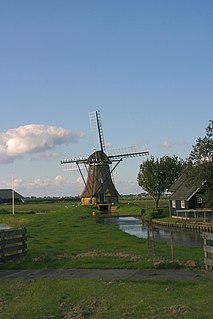
The Grutte Mûne is a smock mill in Broeksterwâld, Friesland, Netherlands which has been restored to working order. The mill is listed as a Rijksmonument, number 11679.

The Molen van Makkum is a smock mill at Makkum, Drenthe, the Netherlands which has been restored to working order. The mill is listed as a Rijksmonument, number 8889.

The Cornwerdermolen is a smock mill in Cornwerd, Friesland, Netherlands which has been restored to working order. The mill is listed as Rijksmonument number 39329.

De Huinsermolen is a smock mill in Húns, Friesland, Netherlands which was built in 1829. The mill has been restored to working order. It is listed as a Rijksmonument, number 8530.

Tochmaland is a smock mill in Kollum, Friesland, Netherlands which was built in 1893. The mill has been restored to working order. It is listed as a Rijksmonument, number 23743.

Meerswal is a smock mill in Lollum, Friesland, Netherlands which was built in 1903. The mill has been restored to working order and held is reserve for use in times of emergency. It is listed as a Rijksmonument, number 39364.

De Grote Molen is a smock mill in Marrum, Friesland, Netherlands which was built in 1845. The mill has been restored to working order. It is listed as a Rijksmonument, number 15637.

De Phenix English: The Phoenix is a smock mill in Marrum, Friesland, Netherlands which was built in 1917. The mill has been restored to working order and is used to train millers. It is listed as a Rijksmonument, number 15602.

De Marsummermolen English: The mill of Marssum is a smock mill in Marsum, Friesland, Netherlands which was built in 1903. The mill has been restored to working order and is used as a training mill. It is listed as a Rijksmonument, number 28624.

Wijnsermolen is a smock mill in Wyns, Friesland, Netherlands which is currently (2011) being restored to working order. The mill is listed as a Rijksmonument, number 35691.

The spinnenkop of the Netherlands Open Air Museum in Arnhem is a small drainage mill originally located near Gorredijk, Friesland, Netherlands. It is a hollow post windmill that has been restored to working order.

't Zwaantje is a smock mill in Nijemirdum, Friesland, Netherlands which was built in 1878. The mill has been restored to working order. It is listed as a Rijksmonument.

De Hoop is a smock mill in Readtsjerk, Friesland, Netherlands which was built in 1911. The mill has been restored to working order. It is listed as a Rijksmonument.

De Schalsumermolen is a smock mill in Schalsum, Friesland, Netherlands which was built in 1801. The mill has been restored to working order. Used as a training mill, it is listed as a Rijksmonument.

De Babuurstermolen is a smock mill in Tjerkwerd, Friesland, Netherlands which was built in 1882 and has been restored to working order. Designated as being in reserve, it is listed as a Rijksmonument.

De Hempenserpoldermolen is a smock mill in Wergea, Friesland, Netherlands which was built in 1863 and has been restored to working order. It is listed as a Rijksmonument.

De Pankoekstermolen is a smock mill in Witmarsum, Friesland, Netherlands which was built in 1900. It has been restored to working order and is designated as being in reserve. It is listed as a Rijksmonument.

Het Fortuyn is a tower mill in the Netherlands Open Air Museum, Arnhem, Gelderland, Netherlands which was built in 1920 and is in working order.

A hollow post mill at the Netherlands Open Air Museum, Arnhem, Gelderland, Netherlands was originally built at Gouda, South Holland, Netherlands. It was dismantled in 1946 and re-erected at the museum. The mill has been restored to working order.

De Kempermolen is a tower mill in Breedenbroek, Gelderland, Netherlands which was built in 1882 and has beem restored to working order. The mill is listed as a Rijksmonument.






















